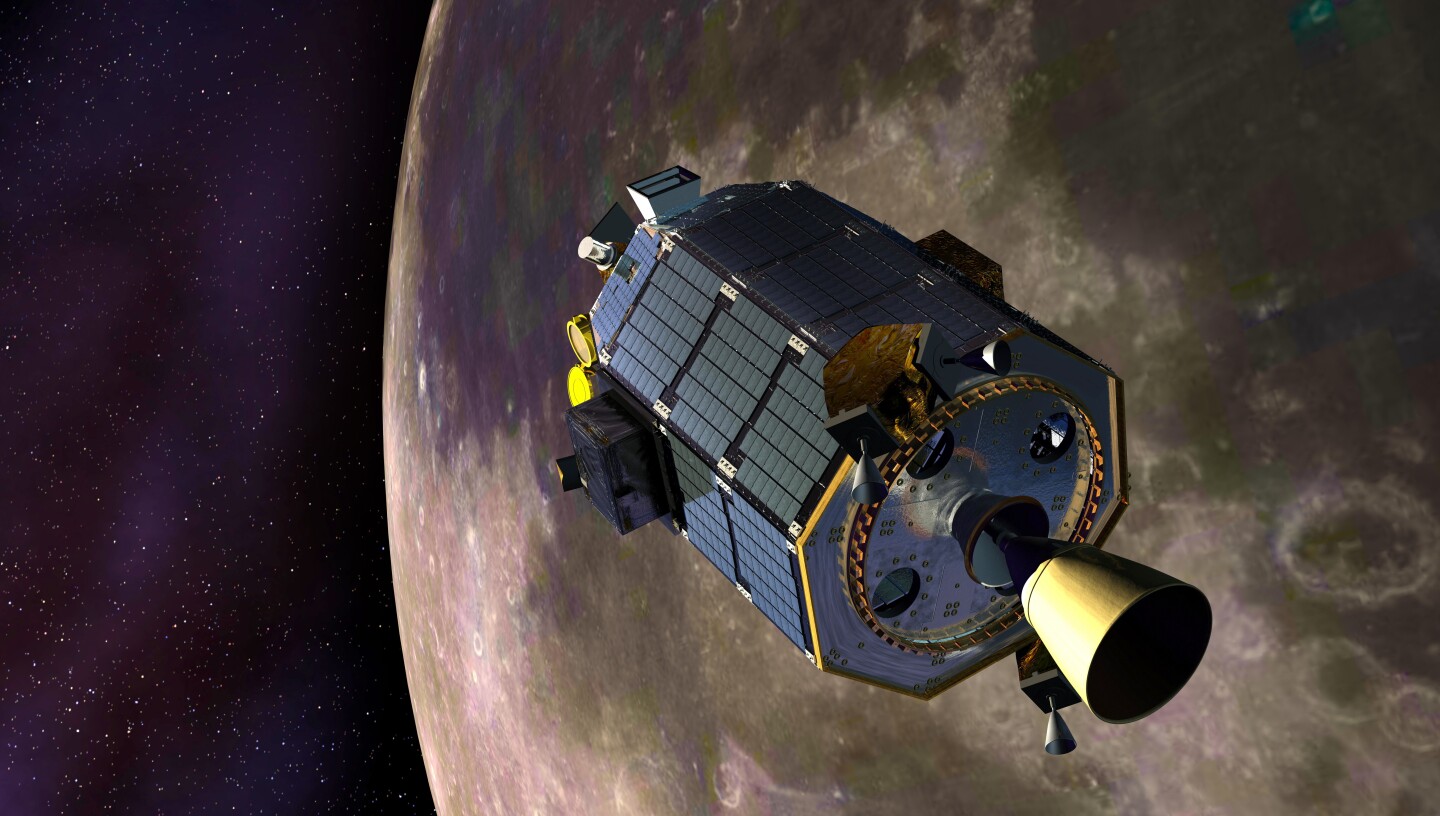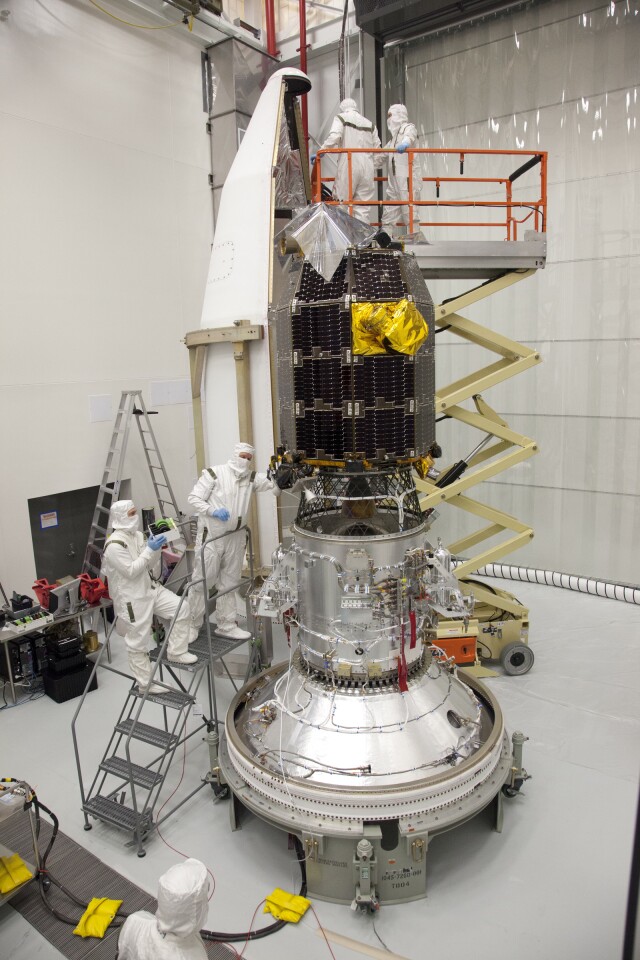On Friday, NASA made a historic launch that sent an unmanned probe to the Moon to study something you could be forgiven for thinking doesn't exist: the Moon's atmosphere. At 11:27 PM EDT, the Lunar Atmosphere and Dust Environment Explorer (LADEE) lifted off from the Mid-Atlantic Regional Spaceport, at NASA's Wallops Flight Facility in Virginia atop a US Air Force Minotaur V launch vehicle provided by Orbital Sciences Corp. The unmanned probe is now on a 30-day journey to the Moon, where it will study the all but non-existent atmosphere of the satellite.
This is the first lunar mission to be launched from Wallops Island and the clear conditions gave onlookers on the US east coast a spectacular show. During the Activation and Checkout phase of the mission, about 23 minutes after launch, LADEE suffered a malfunction when the reaction wheels that control the 844-lb (383-kg) spacecraft’s attitude wouldn’t turn themselves off as programmed.
NASA engineers determined that the problem was in the fault protection limits used to protect the wheels, which had prevented the reaction wheels from shutting down. Mission control ordered the reaction wheels to shut down and the fault protections selectively re-enabled. The spacecraft is currently in safe-mode attitude.

"The initial checkout flight procedure is progressing," says S. Pete Worden, Ames center director. "The reaction wheel issue noted soon after launched was resolved a few hours later. The LADEE spacecraft is healthy and communicating with mission operators."
Getting to the Moon
LADEE is currently in the Phasing Orbits phase of the mission. Unlike the Apollo missions, where the spacecraft was boosted on a giant Saturn V rocket and sent directly to the Moon in three days, LADEE will execute a series of highly elliptical orbits to use the Earth’s gravity to slingshot it into an intercept with the Moon that will take 30 days to complete. Once it reaches the Moon, LADEE will fire its engines for three minutes to go into lunar orbit with subsequent firings putting it into a circular orbit 156 mi (250 km) above the lunar surface where it will circle the Moon once every two hours.After this, LADEE will enter its Commissioning Phase, during which it will go through a 40-day checkout of its equipment and carry out the Lunar Laser Communications Demonstration (LLCD) experiment to demonstrate the use of lasers for high-speed communication with Earth. In the last ten days of commissioning, the spacecraft will lower its orbit to 46.6 miles (75 km).

One fly in the orbital ointment is that the Moon’s gravitational field is very uneven, which means that to maintain a precise orbit at such low altitude will require a number of rocket firings, which will limit the mission to only about 160 days, including a 100-day Science Phase.
The experiments
The Moon has almost no atmosphere, which is a condition that it shares with most moons in the Solar System. This makes the lunar atmosphere the most common type and therefore extremely interesting to scientists trying to understand atmospheres in general.The primary objectives of the US$280 million mission will be to study the global density, composition, and any spatial and temporal variability of the lunar atmosphere, the presence and nature of dust in the atmosphere, and the size, charge, and spatial distribution of electrostatically transported dust grains. The latter are of particular interest, since they have an impact on future lunar exploration and lunar-based astronomy.
LADEE carries a suite of four experimental packages, three of which which will be used during the Science Phase. The first is the Ultraviolet and Visible Light Spectrometer (UVS), which is located on the upper deck of the spacecraft. It’s used to study the composition of the lunar atmosphere and remotely sense any lofted dust by measuring ultraviolet light passing through the atmosphere from the Sun in wavelengths between 230 and 810 nanometers. The light will provide a spectrographic profile of the gases present and the scattering or dimming by dust particles can be measured.

The Neutral Mass Spectrometer (NMS) is mounted to the spacecraft body and measures chemical variations in the lunar atmosphere over multiple lunar orbits. It looks for argon and helium with particular interest in how the solar wind affects the helium content. It also looks for traces of metallic elements and minerals that may have been the result of meteors vaporizing on impact.
The third experiment is the Lunar Dust Experiment (LDEX), it’s on the upper deck of the spacecraft and is designed to detect dust particles. It’s hoped that the LDEX will answer the question of whether dust is kicked up from the lunar surface by ultraviolet light giving the dust particles an electric charge, causing the to rise. This hypothesis is one explanation of the pre-sunrise horizon glow that the Apollo astronauts saw, which shouldn't happen in a hard vacuum.

Finally, there’s the LLCD. This experiment will be used during the Commissioning Phase to demonstrate how lasers can be used to provide communications with bandwidths several orders of magnitude greater than current radio links. The spacecraft will beam data from lunar orbit by laser to a trio of ground stations in the United States and Spain.
The spacecraft
LADEE itself is the result of a new approach by NASA to spacecraft design. Instead of a bespoke system where each probe is a unique one-off, the 7.7 feet (2.37 meters) high LADEE was designed using the Modular Common Spacecraft Bus. The idea here is to make spacecraft out of common components and plug-and-play systems that can be swapped about to suit the mission like an outer space Meccano set. That means that a future lunar lander, for example, may look like a squat LADEE with legs. Similarly a deep space probe may look like a LADEE with a nuclear power system instead of solar panels.The final phase of the LADEE mission is Decommissioning. When the probe has exhausted its fuel, it will no longer be able to maintain a stable orbit. After transmitting the last of its data, the spacecraft will be shut down and allowed to make an uncontrolled crash after natural orbital decay.
The video below shows the LADEE launch from Wallops Island.
Source: NASA




































